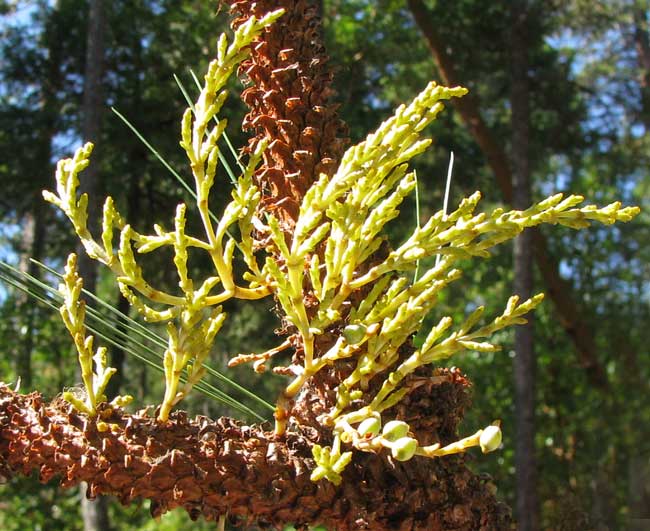
Excerpts from Jim Conrad's
Naturalist Newsletter
from the August 21, 2005 Newsletter issued from the Sierra Nevada foothills
somewhat east of Placerville, California, USA
DWARF-MISTLETOE

Wolf Moss wasn't the only mysterious-looking plant seen on this week's walk. At about eye level on the straight, ten-inch-across trunks of a couple of widely separated young Ponderosa Pines, arising from between bark scales were clumps of slender-stemmed, jointed, forked items looking like scrawny juniperus stems dyed yellow. Having no green to them it was clear that they were parasitic.
The only other things I've seen growing like this were fungi, which are never jointed the way this was, and mistletoe, which bears conspicuous green leaves. However, mistletoe is only half parasitic -- "hemiparasitic," as they say in botany class. Mistletoe steals water and nutrients from its host tree but then photosynthesizes its carbohydrates with its own green leaves, and this item on the pine trunks bore no leaves at all.
The deal is that in western and northern North America there's a genus in the Mistletoe Family that has gone all the way into parasitism, not just halfway, and I had found it. It was Western Dwarf-mistletoe, ARCEUTHOBIUM CAMPYLOPODUM, shown on a Ponderosa Pine branch above.
Being flowering plants, dwarf-mistletoe produces flowers and fruits, and the fruits are amazing things. Mainly, unlike regular mistletoe, whose seeds are dispersed by birds who eat the waxy fruits, dwarf-mistletoe fruits are explosive.
Hydrostatic pressure in the ripening fruit builds to such a point that eventually the slightest touch dislodges the rubbery fruit from its pedicel, and then the seed is shot from an opening at a velocity of 89 feet per second!